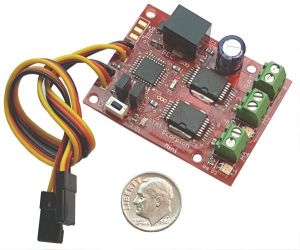ESCs
Electronic Speed Controllers, or ESCs, are circuits that let you control motor speed and direction remotely, using a signal from the radio receiver. One circuit board may have one or more motor controllers, and some small ESCs are integrated with a receiver to minimize size and weight for small bots.
How ESCs work
An ESC plugs into the receiver. It changes the pulses that would have moved a servo, and makes them into a variable motor voltage instead. ESCs have a connection to draw power from the battery, and another to attach to the motor(s).
There are two completely different types.
- Regular, or Brushed ESCs only drive brushed DC motors.
- Brushless ESCs only drive brushless motors.
Selecting an ESC
Note: Beginners may be quickly overwhelmed at the selection of ESCs available. It is most convenient by far to choose ESCs that are specifically sold for use in combat robotics. A wide range of other ESCs are available for model hobby purposes, but you must select carefully.
ESCs may be judged by:
- Voltage of the battery (and by extension, the motors). Never operate an ESC on a voltage greater than its highest rating.
- Current, which along with voltage determines how much power can be delivered to the motors. An ESCs should be rated higher than the stall current of the motor(s) connected to it; several times higher, if possible.
- Cooling, since combat robotics is extremely demanding on its circuits even though most matches are only a few minutes long. An underrated or low-quality ESC will stop working or burn out if it is driven beyond its capacity to stay cool.
- Features: Some ESCs include features like:
- Channel mixing, which lets you operate multiple drive motors with just one control stick, even with the simplest radio transmitters.
- Reversible: If you are using the ESC to operate any motor that has to spin both ways (drive wheels, for example), the ESC must be "reversible" — that is, capable of bidirectional operation.
- Tuning settings, which may help you better control the bot or make the most out of your motors.
- Battery monitoring and protection, which shuts off the motor to save the battery from destruction due to overuse.
- The ability to reflash (reprogram) the ESC; see below.
Reflashing ESCs
Warning: Advanced Topic: Beginners can ignore this section.
We've reached a time in history (and in hobbies) where it seems like every small device is run most cheaply by a tiny computer chip. As a result, ESCs have become very similar and operate according to the same sort of built-in programming, or firmware. Reflashing the firmware changes how the ESC works, and therefore how the motor is driven and powered.
BLHeli[1] is a free and popular replacement firmware package. It's used along with a program on your computer called BLHeliSuite to reprogram brushless ESCs and adjust exactly how the motor is controlled. One common reason to do this is to take brushless ESCs made for other purposes, and make them fit for robot combat.
It may be possible to reflash the firmware on an ESC meant for other uses to make it reversible. Here are some examples of ESCs that could be repurposed for robot combat.
- ESCs for car and truck applications have reversing ability, unless they have the very simplest of radio controls.
- ESCs designed for airplane flight are often intended to spin a propeller one way only. To save weight, airplane ESCs may also have smaller, lighter heat sinks intended for air cooled operation.
- ESCs made for quadcopter/drone applications are normally brushless and non-reversible, but can often be modified by reflashing.
- ESCs for boat duty may not be able to reverse, and some are designed to be water cooled and have no heat sink at all.
